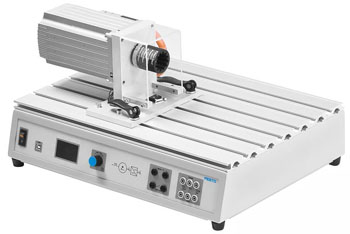Engine test bench


The motor test bench is used to test a connected motor independent of its normal conditions of use. Examinations can be conducted with reference to a given torque or a given rotational speed.
A rotary terminal mechanism, for example at a motor, can be connected to the motor test bench via terminal 1. A specific, predefined load or a specified rotational speed can then be selected at the motor test bench. The selected load or limited rotational speed acts upon the connected shaft as soon as the switch next to the rotary terminal is activated. Not until then is a mechanical connection established, as a result of which the connected motor is subjected to a load.
The way in which the selected torque acts upon the connected motor can be specified in the parameters of the motor test bench under Controlled variable. Torque (braking) means that the selected torque value acts upon the motor as friction or as reaction torque in opposition to the motor’s torque. Torque (driving) means that the motor test bench functions itself as a drive and applies the corresponding torque to the connected axis of rotation. If a rotational speed is specified, torque output or input is adjusted such that the desired rotational speed is attained. With regard to the regulation of rotational speed, maximum torque can be specified as a separate parameter.
This component represents the mechanical section of the motor test bench from Festo Didactic’s equipment set TP 1410, Servo brake and drive system
.
Adjustable parameters
| Designation | Range | Default value |
|---|---|---|
| Controlled variable | Torque (braking), Torque (driving), Revolution | Torque (braking) |
| Torque | -100 ... 100 N.m | 0 |
| Revolution | -30000 ... 30000 1/min | 0 |
| Torque (max) | 0.1 ... 100 N.m | 100 |
| Moment of inertia | 1e-6 ... 10 kg.m2 | 0.0001 |